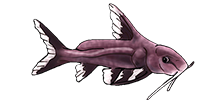The female Taiwan Reef is at least 2 years old and about 3 to 3 1/2". She is the oldest of a working group of 7 females and one 5" male. The cuckoo breeding took place in a 180 US Gallon tank full of peacocks, haps and protomelas species. The was only a single pair of multipunctatus in this tank. Water temp is 78 degrees F, Ph is 8.0, GH 12, Kh 14. Tank is now receiving 16 hours of light per day. Substrate is sand. Lots of rockwork and cover.
Food consisted of a rotation of the following:frozen mysis shrimp, frozen brine shrimp and frozen krill; freeze dried plankton;Cichlid Lovers super flake, spirulina plus flake, plankton-krill-shrimp flakes and micro color pellets. Fresh romaine lettuce leafs, par boiled zuchinni slices and frozen, chopped green beans.
I assume they can be raised on the same foods I feed the peacock fry, live microworms, frozen baby brine shrimp, powered flake food and cyclopezee. Does anyone have any suggestions or comments on this diet.
I have been breeding and rearing bushy nosed, albino plecos for a while but this is my first Synodontis breeding and it is exciting. I currently maintain a fish room (my wife continues to insist on calling it our home VBG) with 22 tanks totaling about 1100 gallons set up with Malawi, Tanganikan and Victorian cichlids so the free multipunctatus will we welcomed. I can't wait to try and duplicate this breeding.




